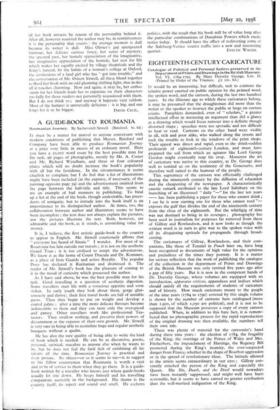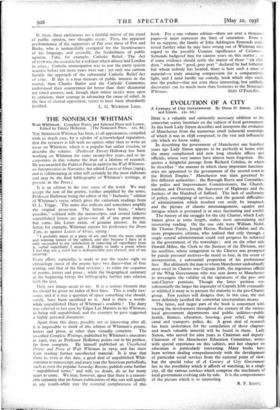EIGHTEENTH-CENTURY CARICATURE
Catalogue of Political and Personal Satires preserved in the Department of Prints and Drawings in the British Museum. Vol. VI, 1784-1792. By Mary Dorothy George, Litt. D. (Printed by Order of the Trustees. £2 12s. 6d.) IT would be an interesting, but difficult, task to estimate the relative power exerted on public opinion by the printed word, the spoken word, and the cartoon, during the last two hundred
years. In the illiterate age to which these caricatures belong, it may be presumed that the draughtsman did more than the writer or the speaker to instruct the public at large on current events. Pamphlets demanded, even of " scholars," a greater
intellectual effort in mastering an argument than did a glance at a drawing which would focus rumour into a definite though distorted shape ; speeches were too sporadic-and too difficult to hear or read. Cartoons on the other hand were visible
to all, rich and poor alike, who walked along the streets and
took the trouble to look in the windows of the print shops. Their appeal was direct and rapid, even to the- drink-sodden proletariat of eighteenth-century London, and must have prepared the soil from which an agitator like Lord George Gordon might eventually reap his crop. Moreover the art of caricature was native to this country, as Dr. George does
well to remind us on the testimony of the Goncourts, and therefore well suited to the humour of the people.
This supremacy of the cartoon was effectually challenged during the nineteenth century by the diffusion of education and the cheapening of the newspaper. A characteristically caustic remark attributed to the late Lord Salisbury on the launching of an illustrated " daily "—" for the last ten years — has been publishing a paper for those who cannot think ; I see he is now starting one for those who cannot read "— exposes the gulf that divides the end of the nineteenth century from the close of the eighteenth. But the whirligig of time was not destined to bring in its revenges ; photography has been used in journalism for purposes far removed from those of Gillray and Rowlandson, and it now looks as though the written word is in turn to give way to the spoken voice with all its disquieting aptitude for propaganda through broad- casting.
The caricatures of Gillray, Rowlandson, and their com-
panions, like those of Tenniel in Punch later on, have long been recognised as documents of high value for the opinions and prejudices of the times they portray. It is a matter
for serious reflection that the work of publishing the catalogue of the collection in the department of Prints and Drawings of the British Museum was only revived five years ago after
a gap of fifty years. But it is now in the competent hands of Dr. Dorothy George, whose volumes are equipped with an introduction, apparatus criticus, appendices and indices which should satisfy all the requirements of students of caricature and of history. How much caricature meant to the people of the nine years (1784 to 5792) covered by this single volume is shown by the number of cartoons here catalogued (more
than 1,900, of which 1,o5o are political), and it is not to be supposed that the Museum possesses a copy of every cartoon published. When, in addition to this bare fact, it is remem- bered that no photographic process for the rapid reproduction of the original drawing was then available, the numbers tell their own tale.
There was plenty of material for the cartoonist's hand during these nine years : the election of 1784, the frugality of the King, the marriage of the Prince_ of Wales and Mrs.
Fitzherbert, the impeachment of Hastings, the Regency Bill promoted during the King's insanity, the ever-suspected danger from France, whether in the shape of Bourbon aggression or in the spread of revolutionary ideas. The latitude allowed to the artists seems extraordinary in our eyes ; Gillray con-
stantly attacked the person of the King and especially the Queen. His Sin, Death, and the Devil would nowadays have been instantly • suppressed, and might well have been actionable, but it seems to have earned no greater retribution
than the well-merited indignation of the King. If, then, these caricatures are a faithful mirror of the trend of public opinion, two thoughts occur. First, the apparent predominance of the supporters of Pitt over those of Fox and Burke, who is unmercifully castigated for the licentiousness of his language, and secondly, the freakishness of public opinion. Take, for example, Catholic Relief. The Act of 1778 was the occasion for a sedition which almost laid London in ashes ; Catholic emancipation was to tear the party system asunder before ten more years were out ; yet only one cartoon heralds the approach of the substantial Catholic Relief Act of 1791. If this is a true measure of public interest in the matter, then Charles Butler and the Catholic Committee understood their countrymen far better than their dictatorial yet timid pastors, and, though their minor tactics were open to criticism, their courage in advancing the cause of relief, in the face of clerical opposition, seems to have been abundantly



















































 Previous page
Previous page